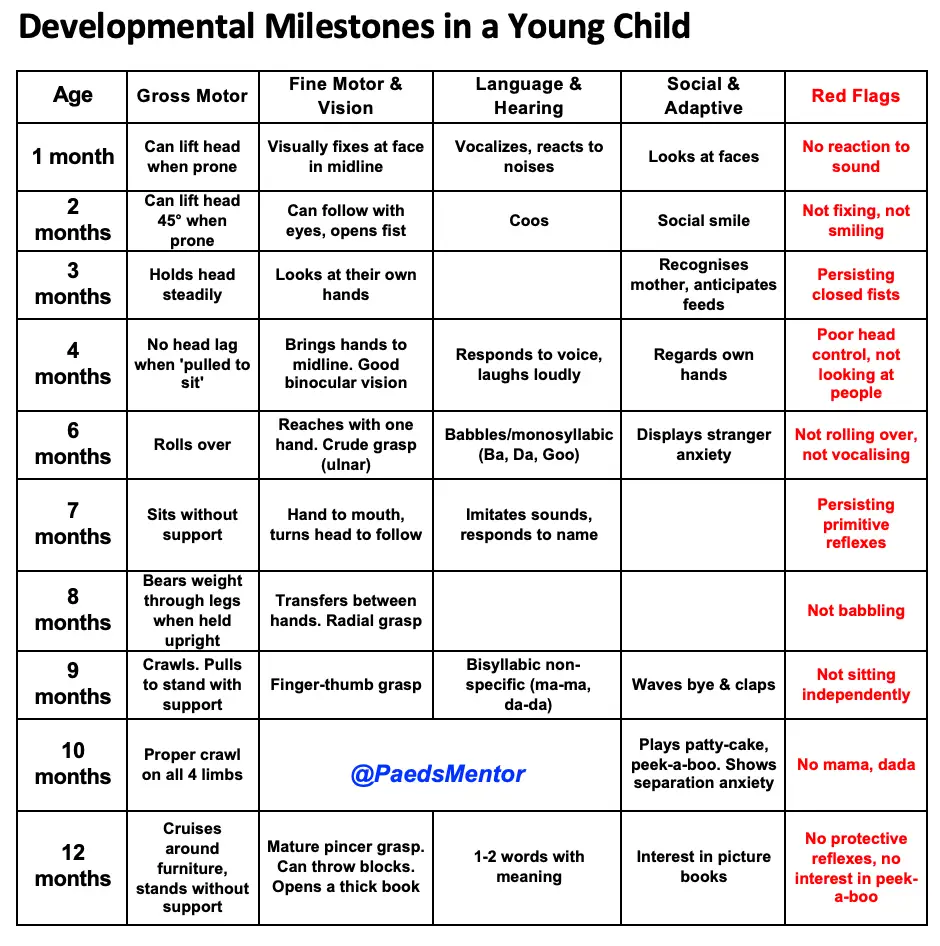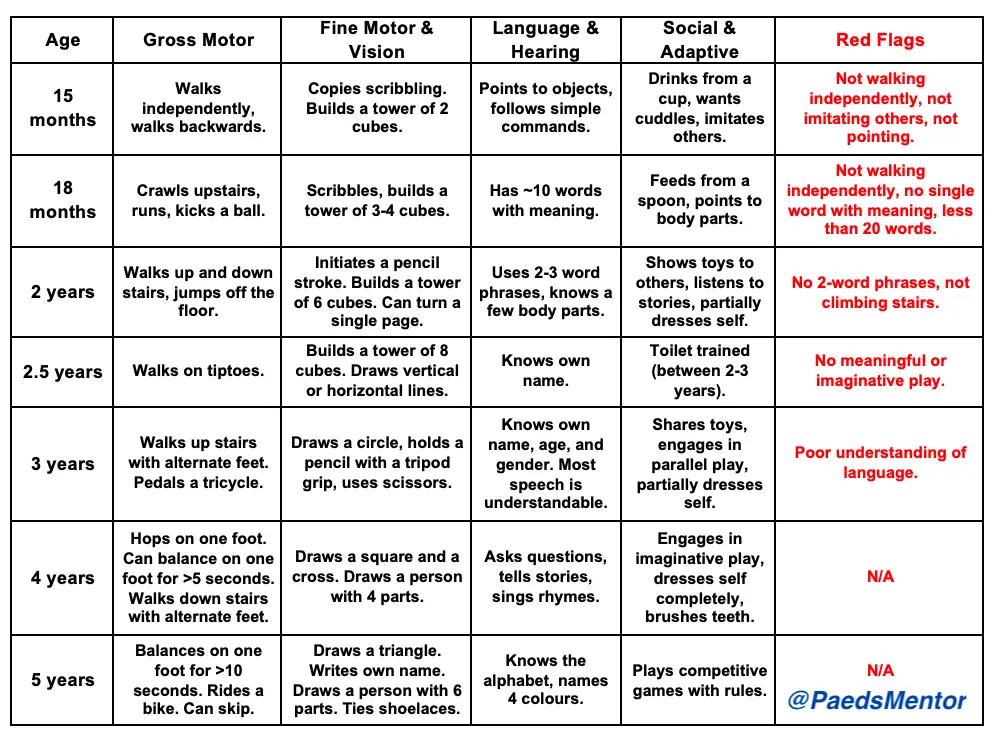Developmental Milestones in Children
Developmental milestones are a set of skills or behaviours that most children achieve by a certain age. They are typically divided into four main domains: Gross Motor, Fine Motor & Vision, Language & Hearing, and Social & Adaptive. Regular developmental checks are a standard part of UK paediatric care. Remember:
The Ages and Stages Questionnaire (ASQ) is a common screening tool used in the UK to identify developmental delays in young children.
The Personal Child Health Record (PCHR), also known as the “Red Book,” is used to record a child’s developmental progress and health information.
Health Visitor Checks: Regular checks by a health visitor or general practitioner are a key part of UK paediatric care.
Red Flags: The term “red flag” refers to a delay that is significant enough to warrant further investigation or specialist referral. It does not automatically mean a serious underlying condition, but it highlights a child who needs a closer look. e.g. persistence of primitive reflexes beyond 6 months is a significant neurological red flag. If multiple red flags are present or there is a persistent concern, a referral to a paediatrician, speech and language therapist, or other specialist is essential.
School Entry Check: A final developmental check is typically performed before a child starts school to ensure they are ready for the academic environment.
Important Considerations and Nuances
Range of Normal: Milestones are a guide, not a strict checklist. There is a wide range of normal. A child who is a bit slow in one area may be advanced in another.
Primitive Reflexes: The persistence of primitive reflexes beyond the expected age is a significant red flag for an underlying neurological issue. These reflexes (e.g., rooting, grasping) should disappear as the child’s nervous system matures.
Parental Concerns: Always take parental concerns seriously. If a parent feels that something is wrong, their instincts are often correct, and a formal assessment should be arranged.
Dominant Hand: While children often develop a hand preference, showing a dominant hand before 18 months is a red flag, as it can indicate a weakness or a problem in the non-dominant hand.
Receptive vs. Expressive Language: A child may have excellent receptive language (understanding) but a delay in expressive language (speaking). This is a nuance that requires careful assessment.
Play: The type of play a child engages in is a powerful indicator of cognitive and social development. The progression from solitary to parallel to interactive and imaginative play is a key milestone in itself.

Key Milestones and Red Flags
Here is a summary of key milestones up to 12 months, with a focus on recognising red flags that warrant further investigation.
1 Month
Gross Motor: Can lift their head off the bed when they are on their tummy (prone).
Vision: Visually fixes on faces.
Hearing & Language: Reacts to loud noises.
Red Flags: No reaction to sound.
2 Months
Gross Motor: Can lift their head to a 45-degree angle when prone.
Social: Starts to develop a social smile.
Red Flags: Not fixing or following with their eyes, not smiling.
3-4 Months
Gross Motor: Holds head steadily, has no head lag when pulled to a sitting position.
Fine Motor & Vision: Starts to look at their own hands and brings them to the midline. They should have good binocular vision.
Language & Hearing: Starts to babble and coo. Laughs loudly and squeals.
Red Flags: Poor head control, not looking at people.
6 Months
Gross Motor: Can roll over from front to back and vice versa. When prone, they extend their arms to lift their head and chest.
Fine Motor & Vision: Can reach for an object with one hand and transfer it between hands. Develops a crude palmar (ulnar) grasp.
Language & Hearing: Babbles with monosyllabic sounds like “ba” and “da.”
Social: Displays stranger anxiety.
Red Flags: Not rolling over or vocalising.
9 Months
Gross Motor: Can crawl and pull to stand with support.
Fine Motor: Develops a pincer grasp to pick up small objects.
Language & Hearing: Starts to use bisyllabic, non-specific sounds like “ma-ma” and “da-da.”
Social: Plays patty-cake and waves bye-bye.
Red Flags: Not babbling or any concerns about hearing loss.
12 Months
Gross Motor: Cruises along furniture and may stand or walk independently.
Fine Motor: Develops a mature pincer grasp. Can throw a block.
Language & Hearing: Uses 1-2 words with meaning.
Social: Plays peek-a-boo and shows separation anxiety.
Red Flags: No interest in peek-a-boo or no meaningful words.

Developmental Milestones and Red Flags for older children
15 Months
Gross Motor: Walks independently and is beginning to walk backward.
Fine Motor & Vision: Copies scribbling and can build a tower of two cubes.
Language & Hearing: Points to objects and follows simple one-step commands.
Social & Adaptive: Drinks from a cup without spilling, wants cuddles, and imitates others.
Red Flags: Not walking independently, not imitating, not pointing.
18 Months
Gross Motor: Can crawl upstairs, run, and kick or throw a ball.
Fine Motor & Vision: Scribbles spontaneously and can build a tower of three to four cubes.
Language & Hearing: Has a vocabulary of around 10 words with meaning.
Social & Adaptive: Feeds themselves with a spoon, points to body parts, and imitates actions.
Red Flags: Not walking independently, no single word with meaning, or a vocabulary of less than 20 words.
2 Years
Gross Motor: Walks up and down stairs and can jump off the floor.
Fine Motor & Vision: Initiates a pencil stroke, builds a tower of six cubes, and can turn a single page in a book.
Language & Hearing: Uses two- to three-word phrases and knows a few body parts.
Social & Adaptive: Shows toys to others, listens to stories, and can partially undress themselves.
Red Flags: No two-word phrases, not scribbling, or not climbing stairs.
2.5 Years
Gross Motor: Can walk on tiptoes.
Fine Motor & Vision: Builds a tower of eight cubes and can draw a vertical or horizontal line.
Language & Hearing: Knows their own name and understands that speech can be a tool for communication.
Social & Adaptive: The child is likely to be toilet trained between 2 and 3 years of age. They also engage in pretend play.
Red Flags: No meaningful or imaginative play.
3 Years
Gross Motor: Can walk up stairs with alternating feet and pedal a tricycle.
Fine Motor & Vision: Can draw a circle and hold a pencil with a more mature tripod grip. They can also use child-safe scissors.
Language & Hearing: Most of their speech is understandable to others, and they can state their name, age, and gender.
Social & Adaptive: They engage in parallel play (playing alongside others but not with them) and can share toys.
Red Flags: Poor understanding of language.
4 Years
Gross Motor: Hops on one foot and can balance on one foot for more than five seconds. Walks downstairs with alternating feet.
Fine Motor & Vision: Draws a square and a cross, and can draw a person with four parts.
Language & Hearing: Asks questions, tells stories, and sings rhymes.
Social & Adaptive: Engages in interactive and imaginative play, dresses themselves completely, and can brush their teeth.
Red Flags: Not yet engaging in interactive or imaginative play.
5 Years
Gross Motor: Balances on one foot for over 10 seconds, rides a bike, and can skip.
Fine Motor & Vision: Draws a triangle, writes their own name, and can draw a person with six parts. They can also tie their shoelaces.
Language & Hearing: Knows the alphabet and can name at least four colours.
Social & Adaptive: Plays competitive games with rules and can go to the toilet alone.
Red Flags: Not yet playing games with rules or unable to dress themselves.
